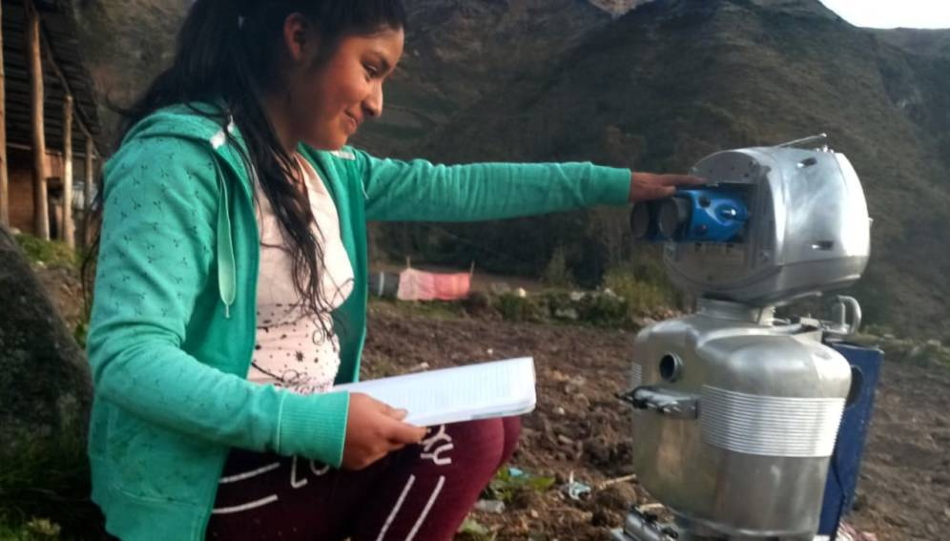Aug 12 2020
An innovative robot has now taken over the classroom in a remote village located in the Peruvian Andes.
 Students can interact with Kipi the robot in Quechua, a native language in the Peruvian Andes, or Spanish. Image Credit: Copyright: Courtesy of Walter Velásquez.
Students can interact with Kipi the robot in Quechua, a native language in the Peruvian Andes, or Spanish. Image Credit: Copyright: Courtesy of Walter Velásquez.
The new robot, called Kipi, was developed by a science and technology teacher. It speaks both Spanish and Quechua—the local language. The robot is making sure that school students do not miss out on the classes that were canceled due to the current COVID-19 pandemic.
There are 33 million inhabitants in this country. But despite this figure, only 30% of the population has access to a stable internet connection, while rural regions have no electricity.
This means the virtual classes broadcast by the Ministry of Education on television and radio cannot be accessed by students.
“Kipi was born because of the pandemic,” teacher Walter Velásquez informed SciDev.Net.
The teacher hails from Colcabamba, a district located in the Huancavelica region, nearly 3000 m above sea level. Situated in one of the most risky regions of the Peruvian Andes, the village is a corridor for a few remaining members of the rebel group, Shining Path, and for drug trafficking.
In the third week of the quarantine, I was very concerned about my students. I had given old radios to some of them but I know in their communities where they live there are not stores for buying batteries and there isn’t electricity either.
Walter Velásquez, Teacher, Centre for Creativity and Inquiry
Velásquez continued, “Also, some mothers in my district told me they were unable to help their kids with the ‘I learn at home’ classes [from the Ministry of Education] because they are illiterate and most of them do not speak Spanish. Some children also have autism or different abilities.”
Therefore, Velásquez immediately focused on creating a robot with whatever materials were there at his Centre for Creativity and Inquiry. He established this center a decade ago to attract students at his school, called Santiago Antunez de Magiolo, to the stream of science and technology.
I wanted my robot to be female as a tribute to a girl that walks almost three hours to school from her community. Also, to highlight the women of role, because there is still great discrimination here—fathers and brothers are the first to eat; if it is necessary to pull out kids from school, girls are the first option before the boys. So, I wished to highlight the important role of women.
Walter Velásquez, Teacher, Centre for Creativity and Inquiry
Upcycling
Upcycled materials were used to develop the Kipi robot, while a solar panel forms her backpack. The robot has been programmed to describe how it converts solar energy into electricity, while motivating students to come with their own inventions using local materials such as stones or sticks.
“In this way, kids awaken their interest in science and technology,” added Velásquez.
The electronic components of the Kipi robot were developed using tiny electronic cards, television pieces, and radio plates. To sequence the lights and movements of the robot, Velásquez also used an open-source electronics platform, called Arduino card, and integrated smart apps into the robot to allow communication with students.
Using a second-hand tablet, the students can instruct the Kipi robot to text in both Spanish and Quechua languages, read poems, dance, and do gymnastics. The robot has been programmed to laugh, or be sad if—for instance—students fail to wash their hands prior to the start of the class.
Since the students lack printers, Velásquez has also created “Kipi books” so that they can practice reading.
Gaining Access
With the closure of schools, the Kipi robot has conducted outdoor classes in several of the 17 peasant communities inhabiting Colcabamba, usually at the foot of the rivers or fenced by glaciers.
Velásquez generally carries the Kipi robot on the back of a llama—an Andean camel used to transport goods—a horse, or a mule.
Because of the lockdown all roads are closed, but they allow us to pass. ‘Here comes Kipi and the teacher, open up all the roadblocks’, the guards shout.
Walter Velásquez, Teacher, Centre for Creativity and Inquiry
At present, the school needs to travel to the communities. However, when classes resume, Velásquez hopes to improve the procedure with the help of students at the Centre for Creativity and Inquiry.
“It is very difficult to teach science and technology on a blackboard, that’s why you have to be resourceful, to prevent them from going to the ‘other side’,” he added, referring to the risks that lure young people in that Andean region.
Digital Divide
According to Johan Baldeón, a professor at the Pontifical Catholic University of Peru’s Faculty of Engineering, the efforts made by Velásquez are motivating and inspiring for his students.
“It is a paradigm shift. He is doing things that awaken, that make students see their reality in a different way and learn that there are things beyond their immediate environment,” added professor Baldeón.
Professor Baldeón, who focuses on the development and use of interactive tools in education, informed SciDev.Net that the current COVID-19 pandemic is shining a light on the digital divide prevalent in Peru—the inequalities in access to, and the distribution of, communications and information technologies.
“It also has to do with digital skills, that is, adequately prepared teachers and parents capable of accompanying their children in educational tasks,” professor Baldeón concluded.
Kipi the robot educating kids in the Andes, Peru
Video Credit: Courtesy of Walter Velásquez.